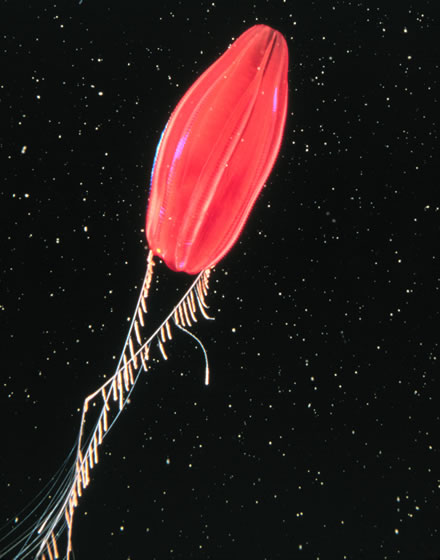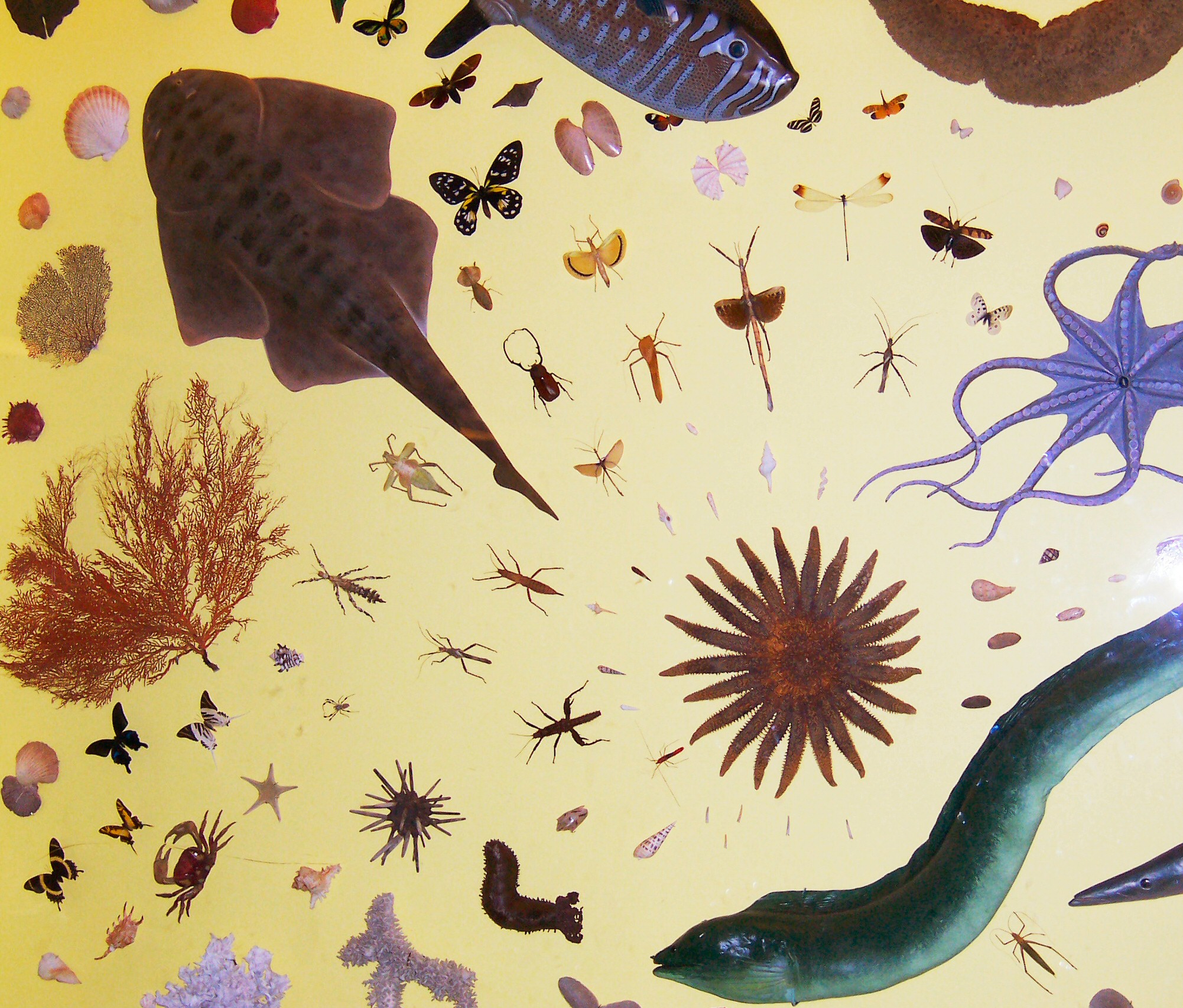|
Hydras
''Hydra'' ( ) is a genus of small freshwater hydrozoans of the phylum Cnidaria. They are solitary, carnivorous jellyfish-like animals, native to the temperate and tropical regions. The genus was named by Linnaeus in 1758 after the Hydra, which was the many-headed beast of myth defeated by Heracles, as when the animal has a part severed, it will regenerate much like the mythical hydra's heads. Biologists are especially interested in ''Hydra'' because of their regenerative ability; they do not appear to die of old age, or to age at all. Habitat Hydras are often found in freshwater bodies, but some hydras are found in open water. They live attached to submerged rocks using a sticky secretion from their base. Morphology ''Hydra'' has a tubular, radially symmetric body up to long when extended, secured by a simple adhesive foot known as the basal disc. Gland cells in the basal disc secrete a sticky fluid that accounts for its adhesive properties. At the free end of the bo ... [...More Info...] [...Related Items...] OR: [Wikipedia] [Google] [Baidu] |
Hydra Vulgaris
''Hydra vulgaris'', the fresh-water polyp, is a small freshwater hydroid with length from 10 mm to 30 mm and width about 1 mm. Description The hydra have four to twelve tentacles that protrude from just outside the mouth. They feed by extending their tentacles and waiting for food to touch the tentacles. They then bring the food to their mouth, ingest and digest the organism. Anything that cannot be digested is egested. Ingestion and egestion occur through the mouth. Like other hydras, ''Hydra vulgaris'' cling to a base object with a "foot" pad, shaped like a disk. The ''Hydra'' moves by releasing its grip on its base and is carried away by the current. ''H. vulgaris'' can also move by bending over, grabbing a surface with its tentacles, releasing its grip with its "foot" and flipping over itself. Model organism ''H. vulgaris'' is often used, like many hydra, as a model organism for morphallactic regeneration because they are easy to care for, requiring minimal direct car ... [...More Info...] [...Related Items...] OR: [Wikipedia] [Google] [Baidu] |
Budding
Budding or blastogenesis is a type of asexual reproduction in which a new organism develops from an outgrowth or bud due to cell division at one particular site. For example, the small bulb-like projection coming out from the yeast cell is known as a bud. Since the reproduction is asexual, the newly created organism is a clone and, excepting mutations, is genetically identical to the parent organism. Organisms such as hydra use regenerative cells for reproduction in the process of budding. In hydra, a bud develops as an outgrowth due to repeated cell division of the parent body at one specific site. These buds develop into tiny individuals and, when fully mature, detach from the parent body and become new independent individuals. Internal budding or endodyogeny is a process of asexual reproduction, favored by parasites such as '' Toxoplasma gondii''. It involves an unusual process in which two daughter cells are produced inside a mother cell, which is then consumed by the ... [...More Info...] [...Related Items...] OR: [Wikipedia] [Google] [Baidu] |
Animal
Animals are multicellular, eukaryotic organisms in the Biology, biological Kingdom (biology), kingdom Animalia (). With few exceptions, animals heterotroph, consume organic material, Cellular respiration#Aerobic respiration, breathe oxygen, have myocytes and are motility, able to move, can reproduce sexually, and grow from a hollow sphere of Cell (biology), cells, the blastula, during embryonic development. Animals form a clade, meaning that they arose from a single common ancestor. Over 1.5 million extant taxon, living animal species have been species description, described, of which around 1.05 million are insects, over 85,000 are molluscs, and around 65,000 are vertebrates. It has been estimated there are as many as 7.77 million animal species on Earth. Animal body lengths range from to . They have complex ecologies and biological interaction, interactions with each other and their environments, forming intricate food webs. The scientific study of animals is known as ... [...More Info...] [...Related Items...] OR: [Wikipedia] [Google] [Baidu] |
Gastrodermis
Gastrodermis (from Ancient Greek: , , "stomach"; , , "skin") is the inner layer of Cell (biology), cells that serves as a lining membrane of the gastrovascular cavity in cnidarians. It is distinct from the outer epidermis and the inner dermis and is primarily associated with the ventral side of cnidarians. It is composed of specialized cells responsible for several vital Physiology, physiological processes. The term is also used for the Analogy, analogous inner Epithelium, epithelial layer of ctenophores. Functions The gastrodermis has a role in many Biology, biological functions, including Respiration (physiology), respiration, pigmentation, and digestion. * The gastrodermis provides a large surface area for gas exchange to occur, via cutaneous respiration, which involves the exchange of oxygen and carbon dioxide through the skin. * The gastrodermis contains specialised cells called chromatophores, which are responsible for producing and controlling pigmentation. These cells co ... [...More Info...] [...Related Items...] OR: [Wikipedia] [Google] [Baidu] |
Squamous Epithelium
Epithelium or epithelial tissue is a thin, continuous, protective layer of cells with little extracellular matrix. An example is the epidermis, the outermost layer of the skin. Epithelial ( mesothelial) tissues line the outer surfaces of many internal organs, the corresponding inner surfaces of body cavities, and the inner surfaces of blood vessels. Epithelial tissue is one of the four basic types of animal tissue, along with connective tissue, muscle tissue and nervous tissue. These tissues also lack blood or lymph supply. The tissue is supplied by nerves. There are three principal shapes of epithelial cell: squamous (scaly), columnar, and cuboidal. These can be arranged in a singular layer of cells as simple epithelium, either simple squamous, simple columnar, or simple cuboidal, or in layers of two or more cells deep as stratified (layered), or ''compound'', either squamous, columnar or cuboidal. In some tissues, a layer of columnar cells may appear to be stratified due ... [...More Info...] [...Related Items...] OR: [Wikipedia] [Google] [Baidu] |
Mesoglea
Mesoglea refers to the extracellular matrix found in cnidarians like coral or jellyfish as well as ctenophores that functions as a hydrostatic skeleton. It is related to but distinct from mesohyl, which generally refers to extracellular material found in sponges. Description The mesoglea is mostly water. Other than water, the mesoglea is composed of several substances including fibrous proteins, like collagen and heparan sulfate proteoglycans. The mesoglea is mostly acellular, but in both Cnidaria and Ctenophora the mesoglea contains muscle bundles and nerve fibres. Other nerve and muscle cells lie just under the epithelial layers. The mesoglea also contains wandering amoebocytes that play a role in phagocytosing debris and bacteria. These cells also fight infections by producing antibacterial chemicals. The mesoglea may be thinner than either of the cell layers in smaller coelenterates like a hydra or may make up the bulk of the body in larger jellyfish. The mesoglea serves as ... [...More Info...] [...Related Items...] OR: [Wikipedia] [Google] [Baidu] |
Diploblastic
Diploblasty is a condition of the blastula in which there are two primary germ layers: the ectoderm and endoderm. Diploblastic organisms are organisms which develop from such a blastula, and include Cnidaria and Ctenophora, formerly grouped together in the phylum Coelenterata, but later understanding of their differences resulted in their being placed in separate phyla. The endoderm allows them to develop true tissue. This includes tissue associated with the gut and associated glands. The ectoderm, on the other hand, gives rise to the epidermis, the nervous tissue, and if present, nephridia. Simpler animals, such as sea sponges, have one germ layer and lack true tissue organization. All the more complex animals (from flat worms to humans) are triploblastic with three germ layers (a mesoderm The mesoderm is the middle layer of the three germ layers that develops during gastrulation in the very early development of the embryo of most animals. The outer layer is the ect ... [...More Info...] [...Related Items...] OR: [Wikipedia] [Google] [Baidu] |
Neurotoxin
Neurotoxins are toxins that are destructive to nervous tissue, nerve tissue (causing neurotoxicity). Neurotoxins are an extensive class of exogenous chemical neurological insult (medical), insultsSpencer 2000 that can adversely affect function in both developing and mature nervous tissue.Olney 2002 The term can also be used to classify endogenous compounds, which, when abnormally contacted, can prove neurologically toxic. Though neurotoxins are often neurologically destructive, their ability to specifically target neural components is important in the study of nervous systems. Common examples of neurotoxins include lead, ethanol (drinking alcohol), glutamate,Choi 1987 nitric oxide, botulinum toxin (e.g. Botox), tetanus toxin,Simpson 1986 and tetrodotoxin. Some substances such as nitric oxide and glutamate are in fact essential for proper function of the body and only exert neurotoxic effects at excessive concentrations. Neurotoxins inhibit neuron control over ion concentrations ... [...More Info...] [...Related Items...] OR: [Wikipedia] [Google] [Baidu] |
Nematocyst
A cnidocyte (also known as a cnidoblast) is a type of cell containing a large secretory organelle called a ''cnidocyst'', that can deliver a sting to other organisms as a way to capture prey and defend against predators. A cnidocyte explosively ejects the toxin-containing cnidocyst which is responsible for the stings delivered by a cnidarian. The presence of this cell defines the phylum Cnidaria, which also includes the corals, sea anemones, hydrae, and jellyfish. Cnidocytes are single-use cells that need to be continuously replaced. Structure and function Each cnidocyte contains an organelle called a cnidocyst, which consists of a bulb-shaped capsule and a hollow, coiled tubule that is contained within. Immature cnidocytes are referred to as cnidoblasts or nematoblasts. The externally oriented side of the cell has a hair-like trigger called a cnidocil, a mechano-chemical receptor. When the trigger is activated, the tubule shaft of the cnidocyst is ejected and, in the case ... [...More Info...] [...Related Items...] OR: [Wikipedia] [Google] [Baidu] |
Tentacle
In zoology, a tentacle is a flexible, mobile, and elongated organ present in some species of animals, most of them invertebrates. In animal anatomy, tentacles usually occur in one or more pairs. Anatomically, the tentacles of animals work mainly like muscular hydrostats. Most forms of tentacles are used for grasping and feeding. Many are sensory organs, variously receptive to touch, vision, or to the smell or taste of particular foods or threats. Examples of such tentacles are the eyestalks of various kinds of snails. Some kinds of tentacles have both sensory and manipulatory functions. A tentacle is similar to a cirrus, but a cirrus is an organ that usually lacks the tentacle's strength, size, flexibility, or sensitivity. A nautilus has cirri, but a squid has tentacles. Invertebrates Molluscs Many molluscs have tentacles of one form or another. The most familiar are those of the pulmonate land snails, which usually have two sets of tentacles on the head: when ext ... [...More Info...] [...Related Items...] OR: [Wikipedia] [Google] [Baidu] |
Symmetry (biology)
Symmetry in biology refers to the symmetry observed in organisms, including plants, animals, fungi, and bacteria. External symmetry can be easily seen by just looking at an organism. For example, the face of a human being has a plane of symmetry down its centre, or a pine cone displays a clear symmetrical spiral pattern. Internal features can also show symmetry, for example the tubes in the human body (responsible for transporting gases, nutrients, and waste products) which are cylindrical and have several planes of symmetry. Biological symmetry can be thought of as a balanced distribution of duplicate body parts or shapes within the body of an organism. Importantly, unlike in mathematics, symmetry in biology is always approximate. For example, plant leaves – while considered symmetrical – rarely match up exactly when folded in half. Symmetry is one class of patterns in nature whereby there is near-repetition of the pattern element, either by reflection or rotation. Wh ... [...More Info...] [...Related Items...] OR: [Wikipedia] [Google] [Baidu] |







